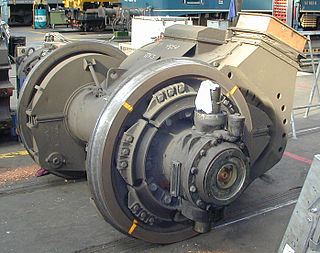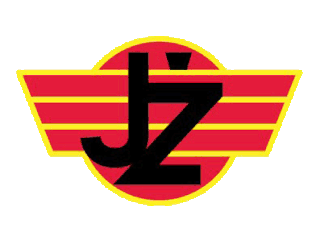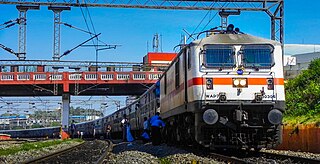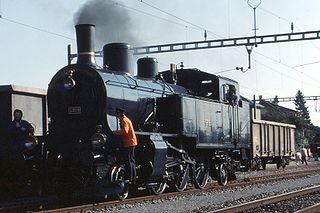
An electric locomotive is a locomotive powered by electricity from overhead lines, a third rail or on-board energy storage such as a battery or a supercapacitor.

The Whyte notation for classifying steam locomotives by wheel arrangement was devised by Frederick Methvan Whyte, and came into use in the early twentieth century following a December 1900 editorial in American Engineer and Railroad Journal. The notation counts the number of leading wheels, then the number of driving wheels, and finally the number of trailing wheels, numbers being separated by dashes. Other classification schemes, like UIC classification and the French, Turkish and Swiss systems for steam locomotives, count axles rather than wheels.
In rail transport, a wheel arrangement or wheel configuration is a system of classifying the way in which wheels are distributed under a locomotive. Several notations exist to describe the wheel assemblies of a locomotive by type, position, and connections, with the adopted notations varying by country. Within a given country, different notations may also be employed for different kinds of locomotives, such as steam, electric, and diesel powered.

On a steam locomotive, a driving wheel is a powered wheel which is driven by the locomotive's pistons. On a conventional, non-articulated locomotive, the driving wheels are all coupled together with side rods ; normally one pair is directly driven by the main rod which is connected to the end of the piston rod; power is transmitted to the others through the side rods.
The UIC classification of locomotive axle arrangements, sometimes known as German classification or German system, describes the wheel arrangement of locomotives, multiple units and trams. It is set out in the International Union of Railways (UIC) "Leaflet 650 – Standard designation of axle arrangement on locomotives and multiple-unit sets". It is used in much of the world. The United Kingdom uses the Whyte notation. The United States uses the simplified AAR wheel arrangement for modern locomotives.
The AAR wheel arrangement system is a method of classifying locomotive wheel arrangements that was developed by the Association of American Railroads. It is essentially a simplification of the European UIC classification, and it is widely used in North America to describe diesel and electric locomotives. It is not used for steam locomotives which use the Whyte notation instead.
A number of different numbering and classification schemes were used for locomotives and multiple units operated by British Railways (BR), and this page explains the principal systems. This section also covers the post-privatisation period, as the broad numbering and classification arrangements have not altered since the break-up of BR.

Under the Whyte notation for the classification of steam locomotives by wheel arrangement, 6-8-6 represents the arrangement of six unpowered leading wheels arranged into a three-axle leading truck, eight powered driving wheels, and six unpowered trailing wheels arranged into a three-axle trailing truck.

Yugoslav Railways, with standard acronym JŽ, was the state railway company of Yugoslavia, operational from the 1920s to the 1990s.

The Indian Railways primarily operates electric and diesel locomotives. Steam locomotives are operated on a few World Heritage sites and also run occasionally as heritage trains. A locomotive is also known as a loco or engine. The country's first steam locomotive ran on the Red Hill Railway from Red Hills to the Chintadripet bridge in Madras in 1837.
B-B and Bo-Bo are the Association of American Railroads (AAR) and British classifications of wheel arrangement for railway locomotives with four axles in two individual bogies. They are equivalent to the B′B′ and Bo′Bo′ classifications in the UIC system. The arrangement of two, two-axled, bogies is a common wheel arrangement for modern electric and diesel locomotives.
PKP classification system is a system of assigning letters and numbers to series and individual locomotives used by the PKP - Polish national railroad operator.
In Whyte notation, a 4-6-6-2 is a steam locomotive with four leading wheels in an unpowered bogie at the front of the locomotive followed by two sets of driving wheels with six wheels each, followed by two unpowered trailing wheels at the rear of the locomotive.
The different railway companies in Germany have used various schemes to classify their rolling stock.
This page explains the numbering and classification schemes for locomotives employed by the Japanese Government Railways, the Japanese National Railways and the Japan Railways Group.

For more than a century, the Swiss locomotive, multiple unit, motor coach and railcar classification system, in either its original or updated forms, has been used to name and classify the rolling stock operated on the railways of Switzerland. It started out as a uniform system for the classification and naming of all rolling stock, powered and unpowered, but had been replaced and amended by the UIC classification of goods wagons.
The DRG locomotive classification system was developed by the German Imperial Railway Company or Deutsche Reichsbahn-Gesellschaft (DRG), which was formed in 1924 following the merger of the German state railways (Länderbahnen) in 1920. A common classification and numbering scheme was needed in order to organise effectively the four hundred or so different steam locomotive classes taken over from the state railways, as well as new locomotives. This process lasted until 1926. Only then was the final renumbering plan fixed.

The DR locomotive classification scheme in East Germany in the initial post-war period used the DRG system, consisting of a class number (Baureihennummer) followed by a serial number (Ordnungsnummer). With the introduction of computerised (EDP) numbers in 1970 as part of the UIC framework, the system was fundamentally changed for the first time.
With the Spanish classification system for locomotive wheel arrangements, the system for steam machines.








